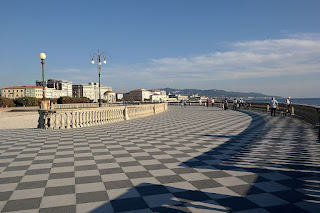Heroic officer who sacrificed his own life
 |
| The destroyer Ugolino Vivaldi was detailed to help rescue the Italian king, Vittorio Emanuele III |
Cavriani, who had risen to the rank of corvette captain in the Italian Royal Navy during World War Two, was lieutenant commander of the destroyer Ugolino Vivaldi as Italy prepared to sign the 1943 Armistice with the Allies.
The Vivaldi and her sister ship, the Antonio da Noli, were ordered on September 8 to set sail from Genoa to Civitavecchia, the large port north of Rome, where the following morning they were to pick up King Vittorio Emanuele III, his head of government, Marshal Pietro Badoglio, and about 50 others, and take them to La Maddalena in Sardinia, to prevent their being captured by the advancing German army.
That mission was aborted after the king, informed that the Germans had already captured the road from Rome to Civitavecchia, instead fled in the opposite direction, to Pescara on the Adriatic coast.
 |
| The Vivaldi was struck by a missile launched from a German Dornier DO17 bomber |
The Da Noli struck a mine and sank. The Vivaldi, badly damaged, managed to limp away but unable to generate anywhere near its normal speed of 32 knots, it was an easy target for German bombers and was further damaged by a guided missile.
It was not long before the ship’s engines failed completely, at which point the order came for her to be abandoned and scuttled, rather than risk the vessel, which was well equipped with guns and torpedo tubes and could carry more than 100 mines, being seized by the enemy.
As the crew evacuated, Cavriani was one of the last to leave, ensuring all the procedures to scuttle the boat had been enacted, before himself swimming to the relative safety of a life raft. On looking back towards the Vivaldi, he became concerned that the destroyer was still afloat.
.jpg) |
| Alessandro Cavriani, who sacrificed his own life |
After they had achieved that and the Vivaldi began to go down rapidly, he and Fasan appeared on the bridge and saluted the Italian flag, soon disappearing beneath the waters, close to the island of Asinara, off the northern coast of Sardinia. In all, the crew of the Vivaldi had 58 dead and 240 survivors, picked up in the water by German or Allied flying boats.
Cavriani, who had learned his maritime skills at the naval academy in Livorno, had previously been decorated with the Bronze Medal for Military Valour following his success in the battles of Punta Stilo and Capo Teulada.
Two years after his death he and Fasan were awarded the Gold Medal for Military Valour, Italy’s highest military honour.
 |
| Livorno's beautiful seafront promenade, the elegant Terrazza Mascagni, is one of the city's attractions |
The port of Livorno is the second largest city in Tuscany after Florence, with a population of almost 160,000. Built during the Renaissance with Medici money as an “ideal town”, it became an important free port, and until the middle of the 19th century was one of the most multicultural cities in Italy thanks to an influx of residents from all round the world who arrived on foreign trading ships. Although it is a large commercial port today with much related industry, and also suffered extensive damage as a prime target for Allied bombing raids in the Second World War, it retains many attractions, including an elegant sea front – the Terrazza Mascagni - and an historic centre – the Venetian quarter – with canals, and a tradition of serving excellent seafood. The Terrazza Mascagni is named after the composer Pietro Mascagni, famous for the opera Cavalleria rusticana, who was born in Livorno.
 |
| Cala Sabina is one of Asinara's beaches, notable for their white sand and clear waters |
Situated just off the northwestern tip of Sardinia, the small island of Asinara has been virtually uninhabited since the maximum security prison to which it was host for 25 years was closed in 1997. The census of population in 2001 listed just one resident. Part of the national parks system of Italy, the island is mountainous in geography with steep, rocky coasts. It was recently converted to a wildlife and marine preserve and is home to a population of wild Albino donkeys from which the island may take its name. Asinara can be reached by boat with summer crossings from Stintino and Porto Torres on Sardinia, with some operators offering a day-long excursion stopping at several of the island’s beaches, notable for white sand and clear water. There is a hostel and restaurant in a former prison guards' barracks at Cala d'Oliva.
Also on this day:
1891: The birth of architect Pier Luigi Nervi
1919: The birth of architect Paolo Soleri
1963: Giovanni Battista Montini elected Pope Paul VI
No comments:
Post a Comment